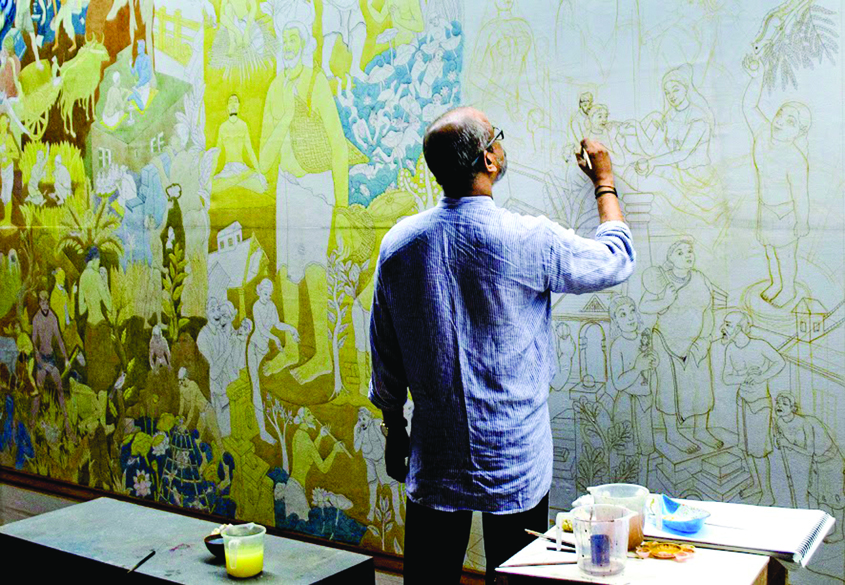Titled Forming in the pupil of an eye, KMB 2016 features the performances and production of 97 artists from 31 countries. There are 36 Indian artists participating in the biennale. The line-up is a mixture of styles, disciplines and sensibilities with writers, dancers, poets, musicians and theatre professionals sharing the biennale space alongside a host of visual
artists.
Talking about the ideas and ideologies which formed the biennale, Sudarshan Shetty, curator, KMB 2016 says, “The eye is the only reflective organ in the body. It reflects as much back into the world as it takes. ‘Forming in the pupil of an eye’ is not an image of one reality, but a reflection of multiple realities and of multiple possibilities in time. My curatorial approach was shaped therefore as a conversation between different streams and forms of art practice. This Biennale is intended as a dialogue between multiple perspectives and possibilities as it evolves within the space and through the duration of the Biennale and beyond.”
“In aid of this, there are art projects this year that will involve spaces and individuals not traditionally associated with the Biennale. For example, Latvian artist Voldemars Johansons has changed the horn sounds on a number of auto rickshaws making them ambassadors of the Biennale as they drive around the city while Argentine writer Sergio Chejfec is writing a 88-chapter novel while moving through Kochi,” Shetty added.
KMB has gained much respect and popularity amongst the art aficionadas of India and abroad but the journey was not easy. Bose Krishnamachari who co-curated the first edition of KMB in 2012 along with Riyas Komu thinks that there were challenges along the way. “It was difficult to convince the patrons for an art event of such a large scale. Projects like this are a kind of risk taking in terms of revenue. But we kept on working to make it a success. The first edition drew from the distinctive heritage of Kochi-Muziris to invent and explored alternative paradigms of cultural practices. In that edition KMB registered a footfall of more than 4,00,000 visitors and was embraced by the local communities and was recognized as an exceptional moment in the journey of an ancient region. KMB 2012 was held at 14 venues, hosting 114 artworks by 89 artists from 23 countries. Over the three month period, the event generated over Rs 100 crore in media value.”
Interesting collaborations in art and culture domain have taken place at KMB 2016 edition.

Art enthusiasts around the world will receive access to an immersive virtual tour of the exhibits and panoramic imagery of KMB 2014. With the foundation entering into a partnership with the Google Cultural Institute, the highlights and delights of Whorled Explorations, the Biennale’s second edition, can be relived at the Google Arts & Culture project. “The KMB seeks to invoke the cosmopolitan legacy of Kochi. The 2014 edition of the Biennale received five lakh visitors from all over the world. With this partnership, the Biennale will be experienced by more people in more places than ever before,” said Riyas Komu, KMB co-founder and Director of Programmes.
An online portal documenting India’s cultural heritage, Sahapedia has crafted an interactive map of Fort Kochi. The map will give visitors an intimate experience of the town’s famed connections to the Portuguese, the Dutch, the British, the Chinese, the Arabs and others though the memories and perspectives of people who have lived here. Sahapedia has put together the map with details of over 150 sites and practices — cultural centres, heritage sites, lifestyles, places of worship, public spaces and public institutions in Fort Kochi and nearby Mattancherry.
“Kochi is a place with great creativity, great history, great art and heritage. Fort Kochi was the gateway to India from people around the world who visited, did trade and some of them even settled down here and got married and became a part of the place. It became an ideal place for us to start this fascinating project of cultural mapping,” says Dr Sudha Gopalakrishnan, Executive Director, Sahapedia.
Internationally renowned French-Bengali artist Chittrovanu Mazumdar will present a site-specific installation spanning several
In Chittrovanu’s large scale installation, the viewer exists at the centre of this enquiry, finding him or herself in the middle of a series of choices. The backdrop to these choices is a constant, low hum of the unknown. The artist references water as a space of transition, existing in stories and myths as a place of passage: a medium of cleansing, and an instrument for ritual. Set in darkness, the main room contains a black metal tunnel, leading to nowhere in particular. Revelation is in the act of passing — the centre of the bridge is riddled with incandescent lights and errant wires. This sea of electrical accumulation seems at once mesmerizing and treacherous.
Celebrated muralist P.K. Sadanandan is presenting his new piece at KMB. Begun as soon as the first planks went up at the Biennale’s main venue in October, the in situ mural covering measuring 15m x 3m is intended to be a work in progress over KMB 2016’s nearly four-month run. Both the production and its preparation are a study in meticulousness. “My subject has great significance when considering the present scenario on caste hegemony and issues pertaining in contemporary Indian society. This art work will evolve during the period of the Biennale,” he said.

